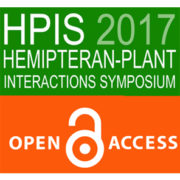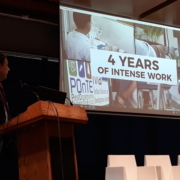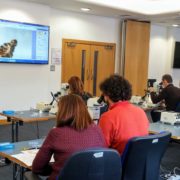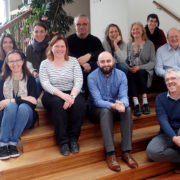The identification and detection of psyllid vectors of CaLsol in suction traps
Proceedings of the 3rd Hemipteran-Plant interactions Symposium (HPIS 2017), Madrid, Spain, 4-8 June 2017. doi.org/10.5281/zenodo.818688
Sjölund MJ1, Carnegie M1, Greenslade AFC2, Ouvrard D3, F Highet1, Kenyon DM1, Sigvald R4, Bell JR2
1Science and Advice for Scottish Agriculture (SASA), RoddinglawRoad, Edinburgh EH12 7FJ, UK. 2Rothamsted Insect Survey, Rothamsted Research, West Common, Harpenden, Hertfordshire, AL5 2JQ, UK. 3Dept. of Life Sciences, Natural History Museum, Cromwell Road, London SW7 5BD, UK. 4Dept. of Ecology, Swedish University of Agricultural Sciences, Box 7044 750 07 Uppsala, Sweden
Abstract Oral Presentation
Candidatus Liberibacter solanacearum (CaLsol) is an α-proteobacterium that infects several solanaceous and apiaceous crops. It is vectored by three species of psyllid – Bactericera cockerelli in the Americas and New Zealand; Bactericera trigonica in Europe and the Mediterranean, and Trioza apicalis in Northern Europe. CaLsol is the causal agent of zebra chip disease in potato that has led to huge economic losses in America and New Zealand. The European haplotypes are primarily associated with apiaceous crops, largely in carrot, although recent evidence suggests they can infect potato, albeit at low levels. There are approx. 3800 species of psyllid worldwide. Many psyllid species, including vectors, lack taxonomically useful characteristics and can be easily misidentified. With only three known vectors, their accurate identification is crucial to monitor known/potential vectors and gain an understanding of psyllid biology and ecology, building on our understanding of epidemiology and improving pest risk analyses. Information on the distribution of several important species remains incomplete, especially for Scotland – the second biggest producer of seed potatoes in Europe. We reviewed and surveyed psyllid populations using a network of 12.2m suction traps in England, Scotland and Sweden (Rothamsted Insect Survey and EXAMINE networks). We found new species for all three countries, with several species displaying a summer and autumn population peak. The main vector in Sweden and England – T. apicalis, was caught in both countries, highlighting the networks potential as a monitoring/surveillance system for vectors. Species identification was carried out using classical taxonomy, in combination with molecular tools including non-destructive DNA extraction and DNA sequencing. Species-specific real-time PCR assays have been designed for two known, and one potential, vector to facilitate the rapid identification of species. Bulk DNA samples from suction trap catches are currently being used to test the assay sensitivity.
This project has received funding from the European Union”s Horizon 2020 research and innovation programme under grant agreement No 635646: POnTE (Pest Organisms Threatening Europe)
Published on June, 2017 by HPIS.CSIC








